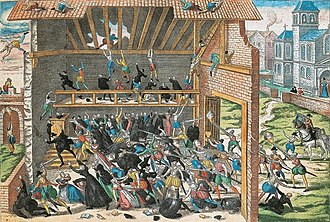Massacre de Vassy in 1562, print by Hogenberg end of 16th century.
On this day in 1562 – 63 Protestant Huguenots were massacred by Roman Catholics in Wassy (Vassy), France, marking the start of the French Wars of Religion, leading eventually to the Battle of the Boyne.
After the ascent of Henry II to the French throne, followers of the religious teachings of John Calvin, known as Huguenots, were persecuted in France. Catherine de’ Medici, regent of Charles IX, proposed the Edict of January (or Edict of Saint-Germain) with the hopes that Calvinism and Roman Catholicism could co-exist in France and that fighting would cease.
On 1 March 1562, Francis (François), the second Duke of Guise, travelling to his estates, stopped in Wassy (Vassy) and found a large congregation of Huguenots peacefully holding their service in a barn that was their church. Some of the duke’s party attempted to push their way inside to stop them and were repulsed. The duke then ordered his men to fortify the town and set fire to the church, killing 63 unarmed Huguenots and wounding over a hundred.
The massacre provoked open hostilities between some followers of each religion, sparking the first war of a long series of French Wars of Religion, which continued largely uninterrupted for more than a century.
The Bourbons, led by the Prince of Condé, and proclaiming that they were liberating the king and regent from “evil” councillors, organised a kind of protectorate over the Protestant churches and began to seize and garrison strategic towns along the Loire. Although the Huguenots had begun to mobilise for war before Vassy, Condé used the massacre as evidence that the Edict had been broken, lending further weight to his campaign, and as hostilities broke out, the Edict was in fact revoked under pressure from the Guise faction.
The major engagements of the war occurred at Rouen, Dreux and Orléans. At the Siege of Rouen (May–October 1562), the crown regained the city at the cost of Antoine de Navarre, who died of his wounds. The Battle of Dreux (December 1562), saw the capture of Condé by the Guises and Montmorency, the governor general, by the Bourbons. In February 1563, at the Siege of Orléans, Frabcis, Duke de Guise was shot and killed by the Huguenot Poltrot de Méré; the Guise considered this an assassination on the orders of the duke’s enemy, Admiral Coligny, as it was outside of direct combat. The popular unrest caused by the ‘assassination’, coupled with the fact that Orléans was holding out in the siege, led Catherine to mediate a truce and the Edict of Amboise (1563).
One result was the eventual growth of the Linen industry in Ulster, which set the scene for the industrialisation of Belfast. My friend Professor Rene Frechet of the Sorbonne in Paris was a devout Huguenot, and to him and my friend Dr Ian Paisley I dedicate this day.
But it is also Saint David’s Day (Welsh: Dydd Gŵyl Dewi), the feast day of Saint David, the patron saint of Wales. This falls on the 1st of March each year, the day having been chosen in remembrance of the death of Saint David for tradition holds that he died on that day in 589. The date was declared a national day of celebration within Wales in the 18th century.
St David (Welsh: Dewi Sant) was born towards the end of the fifth century. He was a scion of the British royal house of Ceredigion, and founded a Celtic monastic community at Glyn Rhosyn (The Vale of Roses) on the western headland of Pembrokeshire (Sir Benfro), at the spot where St David’s Cathedral stands today. David’s fame as a teacher and ascetic spread throughout the Celtic world. His foundation at Glyn Rhosin became an important Christian shrine, and the most important centre in Wales. The date of Dewi Sant’s death is recorded as 1 March, but the year is uncertain – possibly 588. As his tearful monks prepared for his death St David uttered these words: ‘Brothers be ye constant. The yoke which with single mind ye have taken, bear ye to the end; and whatsoever ye have seen with me and heard, keep and fulfil’.
